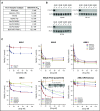Preclinical studies of gilteritinib, a next-generation FLT3 inhibitor
- PMID: 27908881
- PMCID: PMC5234222
- DOI: 10.1182/blood-2016-10-745133
Preclinical studies of gilteritinib, a next-generation FLT3 inhibitor
Figures


References
-
- Grunwald MR, Levis MJ. FLT3 inhibitors for acute myeloid leukemia: a review of their efficacy and mechanisms of resistance. Int J Hematol. 2013;97(6):683-694. - PubMed
-
- Smith BD, Levis M, Beran M, et al. . Single-agent CEP-701, a novel FLT3 inhibitor, shows biologic and clinical activity in patients with relapsed or refractory acute myeloid leukemia. Blood. 2004;103(10):3669-3676. - PubMed
-
- Fischer T, Stone RM, Deangelo DJ, et al. . Phase IIB trial of oral Midostaurin (PKC412), the FMS-like tyrosine kinase 3 receptor (FLT3) and multi-targeted kinase inhibitor, in patients with acute myeloid leukemia and high-risk myelodysplastic syndrome with either wild-type or mutated FLT3. J Clin Oncol. 2010;28(28):4339-4345. - PMC - PubMed
Publication types
MeSH terms
Substances
Grants and funding
LinkOut - more resources
Full Text Sources
Other Literature Sources
Medical
Molecular Biology Databases
Miscellaneous

